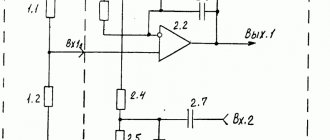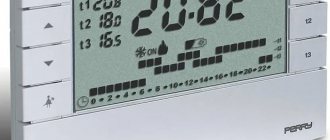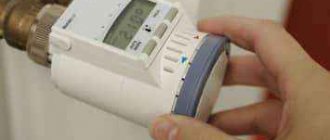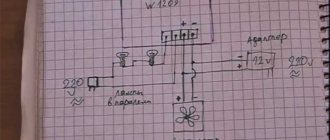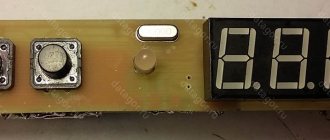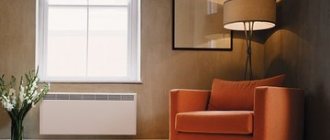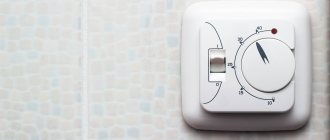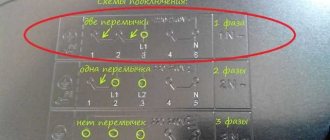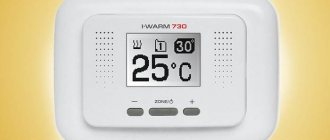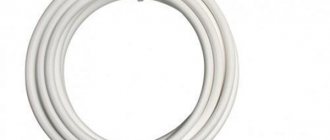Installation nuances
We will not go into the types and types of regulators, or arrange comparisons and tournaments. All of them are good in their own way and will fulfill their purpose, serving faithfully. The first thing you want to pay attention to is the installation location. Doesn’t depend on what type of heaters you have: infrared, panel, heated floor, convection.
Installation of a thermostat with an air temperature sensor is prohibited in the following places:
- in close proximity to heaters;
- in places where there is a draft;
- in the heating zone of infrared emitters.
All these places are unsuitable for placing a thermostat, since when located near the heater, the air next to it will heat up to the desired temperature earlier, which will lead to false operation, as a result of which the room will not heat up to a comfortable temperature.
If you install the thermostat in the heating zone of the IR heater, its body will heat up earlier and distort the sensor readings. In places where there is a draft, the sensor will not show the desired temperature and the heaters will overheat the room, consuming excess electricity. The height of the temperature sensor should be placed in the comfort zone, at a level of 1.5 meters from the floor.
Types of thermostats
Thermostats are divided into mechanical and electronic. The price of the latter is higher, as they can perform a number of additional functions. Each type will be discussed in more detail below.
Mechanical thermostat diagram.
Mechanical regulators are produced by many companies, but they differ little from each other. Almost all models are mounted on the wall in a mortise or overhead manner, which allows them to be connected to any type of wiring.
Inside the device there is a thermocouple, the sensitivity of which determines the accuracy and price of the entire device. The standard error is no more than 0.5 °C. The adjustment limit is 5-30 °C. Thermoregulators for IR heaters are similar in principle to relays, which are activated when the temperature rises or falls to a given value (there are input and output contacts, and the regulator’s task is to close and open them). The operation of this device is completely mechanical, that is, it does not need to be powered from a stationary 220 V network.
Electronic regulators are distinguished not only by the presence of a liquid crystal display and clarity of operation, but also by the ability to program the operation of the heater for the day, week or month in advance. What must be done manually on mechanical devices is done automatically here. This is very convenient: if you are at work or on a business trip, the infrared heater can operate at minimum power, periodically warming up the room, and heating the air to a comfortable value can be started 10-20 minutes before you return home.
Connection diagrams
Always, before installing and connecting the thermostat, read the instructions and passport data for the device. Since the manufacturer indicates the required cable cross-section and provides a connection diagram for its products. If you deviate from the requirements and save on wires and thermostats, there is a high probability of equipment failure or fire hazard.
To connect heaters, it is usually recommended to use a 2.5 mm three-core PVA wire. It is recommended to connect the thermostat with the same wire.
Connection diagram of the thermostat to an infrared heater with a power of up to 3.5 kW:
If the room is heated by a group of heaters up to 3.5 kW, then the connection diagram will look like this:
If you are the owner of a three-phase network and heating is carried out by a group of heaters with a total power of more than 3.5 kW, then a magnetic starter is added to the control circuit, which is controlled by a thermostat:
This is the principle used to install a temperature controller. As you can see, there are some features in installing and connecting the thermostat, so it is important to first read the instructions from the manufacturer and then proceed with the main process.
Finally, we recommend watching a video that clearly demonstrates the technology for connecting contacts using the example of a fairly popular thermostat from Ballu BMT-1:
You probably don't know:
Unlike radiators, infrared heaters help provide heating over a larger area at a much lower temperature. This makes it possible to heat modern homes economically. To ensure thermal comfort for users and controlled operation of floor equipment, controls should be used. Below is information on how to connect the Ballu BMT 1 and BMT 2 thermostat, the features and advantages of these devices.
Thermostat connection options
Now you need to figure out how to connect the thermostat to an infrared heater if you do not have any experience in such work:
- A micathermic heater for a home should not have a power of more than 3 kW.
- It is not recommended to install the thermostat directly next to the device.
- Avoid direct sunlight on the thermostat housing.
- It is not advisable to connect an infrared heater to a thermostat in rooms with high humidity.
Control via TDC thermostat
Thermal comfort is a subjective feeling for each person. This is a condition in which people perform normal household work without becoming overheated or exposed to cold. Thermostats are needed to regulate the temperature and help infrared heaters function properly. TDC is a modern electronic feedback device that maintains an exact set temperature.
Its control system is very simple and at the same time effective - you should set the value that you want to achieve in the selected room. Sensors detect the temperature and then turn on the device to achieve the desired value. After this, the heating devices automatically turn off. The next switching occurs when the temperature begins to drop. This control system saves energy - the heaters operate only about 4-6 hours a day.
Before answering the question, TDC thermostat 1: how to connect, you should know that the temperature in the apartment largely depends on the location of the heater. It is recommended to install it in an accessible place, away from drafts (windows, doors).
Installation Tips
When installing a thermostat yourself, you should take care to follow basic safety rules:
- the grounding loop is made of a conductor of a certain thickness and with low resistance;
- the best place to place the thermostat is a wall;
- in one room - one device;
- it should be left open, without masking with fabric, curtains, interior items, etc.
Thus, an infrared heater equipped with a thermostat allows you to save energy, warm up the room in advance and facilitate the climate control process
It is important to correctly connect the thermostat to the heating device. Strict compliance with the instructions guarantees safe and long-term operation of the device
Infrared heaters come in a wide variety, but not all models are equipped with thermostats. This device allows you to control the operation of the device, ensuring uniform and efficient heating of the room. You can connect the thermostat with your own hands, and knowledge of the features and the correct choice of this part ensure ease of work.
Main advantages
The main advantages of TDC thermostats include:
- ease of use (just use the dial to set the desired room temperature);
- low purchase and subsequent maintenance costs.
Thus, controlling the temperature inside the house allows you to maintain sufficient thermal comfort and reduce heating costs.
Thermostat Ballu BMT 1: how to connect
The most common and well-known to many is a thermostat with an air temperature sensor Ballu BMT 1. It has proven itself in operation.
Sequence of work:
First of all, you need to choose a place to install the heater. After this, you can start laying the wires. To ensure fire safety, you should choose a wire with a cross-section of at least 2.5 mm 2.
Note! This thermostat is suitable for connection to open and hidden wiring.
Having laid the cables, we install the thermostat. Next, we connect the device. To do this, you need to understand the circuit, since many people are completely unclear how to connect the device correctly.
Before installation
You should know that the answer to the question: BMT thermostat 2 - how to connect, is directly related to the installation of Ballu BMT 1. To install them safely, it is recommended to follow the following precautions:
- Before starting work, turn off the heater from the mains;
- Use wires with standard colors and suitable cross-section.
Meaning of wire colors:
- brown phase – control cable;
- blue phase – neutral wire N (“zero”);
- red or black – phase conductor.
It is recommended to use wires with a cross section of 1.5 mm2.
Direct connection of IR heater
The simplest, but at the same time inconvenient installation method is a direct connection to a household electrical network.
A power cord from the kit or purchased separately is connected to the terminals, which is plugged into a standard 220V socket.
This scheme is only suitable if your model of heating device has a built-in thermostat.
The disadvantages are obvious:
— Inability to automatically regulate temperature
The device will have only two operating modes, either on or off. You will have to change them manually. The principle here is simple - as soon as it gets cold, you turn it on, if it gets hot, turn it off.
— You cannot connect several IR heaters to one outlet
You depend on the number of electrical outlets and their location when choosing a location, installation method and the number of heaters in the room. The socket mechanisms have a maximum connected current, most often no more than 16A; accordingly, you can connect no more than 3 kW of electrical power to it. The problem of lack of socket mechanisms is also acute, because... You cannot connect heating devices through tees; there is always a risk of fire from overheating.
— One of the electrical outlets is occupied
If you did not previously plan to install additional electric heating devices, or did not install a special socket or outlet for this, you will have to use one of the existing mechanisms, which are often not superfluous.
- Requires manual switching on and off
To adjust and even simply control the operation of the equipment, you need to turn it on and off yourself, and this is terribly inconvenient.
- Appearance
External installation, when wires pass along the surface of the walls, even in a cable channel, this always spoils the appearance of the interior.
Main advantages:
— Easy installation
It all comes down to connecting the power cord to the terminals of the device and installing it into the outlet connector. The following advantage follows from this:
— Sales cost
Often, everything you need is always at hand and there is no need to purchase additional equipment or electrical materials.
— Ability to use the existing network of an apartment or house
Most often there is no need to lay separate power lines to the installation site. It is enough to use the existing apartment socket network.
CONCLUSION: It is recommended to use a direct connection only as a temporary connection, for example, at a time when the electrical wiring is not yet ready, the rest of the electrical equipment has not been installed or delivered, and the room already needs to be heated. At the same time, it is imperative to control the area in which the heating equipment is located and not leave it unattended.
In addition, this is a good option if the IR heater has a built-in thermostat. Then the main disadvantages will be different:
— it is not always convenient to make adjustments, because often devices are suspended from the ceiling
— You will have to occupy one of the sockets in the room
— External installation spoils the overall appearance of the interior
Installing a thermostat
A few words about how to connect the Ballu TDC thermostat 1. Installation of the device must proceed sequentially:
- Pull back the thermostat cover and remove the screws and plugs.
- Use an indicator screwdriver to determine the phase in the socket.
- Connect the brown wire (phase) to the sensor.
- According to the diagram, connect one end of the heater to the third wire.
- Connect the blue wire to the remaining end.
- Place a jumper between the third and fifth wires.
- After an intermediate test, in which the device is rung to see if the thermostat is working, a plastic box is put on.
The figure below shows how to connect the Ballu BMT 1 thermostat according to the connection diagram. Wiring is laid to the location of the device, which is connected to zero or phase.
For the Ballu BMT 2 thermostat, the connection diagram is similar to the one shown above, only the terminal numbers are different. After installation, the device is connected to the infrared heater using a separate line.
Selecting a thermostat
Gas infrared heater - a reliable assistant in the fight against the cold
Connection diagram for infrared heater.
One of the main characteristics of a thermostat is its maximum power (current)
Therefore, when choosing this device, you need to pay attention to this value. The thermostat can simultaneously control the operation of several heating units, so there can be one for the whole house
In this case, it is important to observe one condition: the maximum connected load must be 15% higher than the total power of the IR heaters. . For example, the controller power is 3 kW, and 3 heaters are used to heat the house: 1 kW, 1 kW and 0.5 kW
Their total power will be: 1+1+0.5 = 2.5 kW. Therefore, to control their operation, one 3 kW thermostat is sufficient (2.5 * 0.15 + 2.5 = 2.875 kW).
For example, the controller power is 3 kW, and 3 heaters are used to heat the house: 1 kW, 1 kW and 0.5 kW. Their total power will be: 1+1+0.5 = 2.5 kW. Therefore, to control their operation, one 3 kW thermostat is sufficient (2.5 * 0.15 + 2.5 = 2.875 kW).
Control via TDC thermostat
Thermal comfort is a subjective feeling for each person. This is a condition in which people perform normal household work without becoming overheated or exposed to cold. Thermostats are needed to regulate the temperature and help infrared heaters function properly. TDC is a modern electronic feedback device that maintains an exact set temperature.
Its control system is very simple and at the same time effective - you should set the value that you want to achieve in the selected room. Sensors detect the temperature and then turn on the device to achieve the desired value. After this, the heating devices automatically turn off. The next switching occurs when the temperature begins to drop. This control system saves energy - the heaters operate only about 4-6 hours a day.
Before answering the question, TDC thermostat 1: how to connect, you should know that the temperature in the apartment largely depends on the location of the heater. It is recommended to install it in an accessible place, away from drafts (windows, doors).
How to connect a thermostat to an infrared heater
Using a thermostat is very convenient; you just need to determine how to properly connect the thermostat to an infrared heater in order to get the maximum effect from using this device.
Necessary materials
Preparing to install the thermostat will not take much time, nor will the installation itself. Even if you have no experience connecting thermostats, you can easily do all the work yourself.
But if you do not have experience working with electrical equipment and even installing a socket is difficult, and you are not familiar with the operating principle of an indicator screwdriver, you should not try to figure out how to connect a mechanical or electronic thermostat. In such cases, it is safer to entrust this work to a professional.
For those who are well versed in electricity and know for sure that before work they should turn off the power to devices and equipment, it is necessary to prepare the following set of tools:
- Drill or screwdriver. They are only needed to drill a hole in the wall to mount the thermostat.
- Pliers for working with electrical cables.
- Indicator screwdriver or tester.
- Pencil, tape measure. They will help determine and mark the place where the temperature regulator will be located.
Also for work you will need an electrical cable that will connect the thermostat and the infrared heating device, a collapsible socket and hardware for attaching the regulator and fixing the cable. When the materials and tools are prepared, you can begin marking and installation.
Connection diagram
The connection diagram of the thermostat to the infrared household heater is selected depending on the device used, the experience and knowledge of the electrical installation specialist.
Standard
In the standard scheme, the thermostat is installed in a ready-made network between the heater itself and the circuit breaker on the panel. The starting point of the network will be the machine. Two wires come from it - phase and zero, which are connected to the corresponding contacts of the thermostat. There are also two wires coming from the thermostat, which are connected to the heating device.
This scheme is also convenient if two or three heaters need to be connected to one thermostat. Located in different rooms, they ensure the same temperature throughout the apartment. For their effective operation, the connection is made as follows:
- Two wires lead from the machine to the thermostat: phase and zero.
- Two wires come from the machine for each heating device.
- Infrared heaters do not connect to each other.
Parallel connection will allow you to safely control several devices at once, without purchasing additional controllers for each of them.
Using a magnetic starter
This scheme is a little more complicated and will take a little longer. But thanks to the use of additional equipment in the form of a magnetic starter, it is possible to connect several heaters to one thermostat at once, including equipment with higher power and industrial systems.
Devices are connected in the following sequence:
- A thermostat is connected to the machine using a cable (phase and neutral).
- The thermostat is connected to the magnetic starter through the output terminals.
- The magnetic starter is connected to heating devices.
In this case, the circuit for connecting the magnetic starter is calculated individually. This will ensure the devices operate safely and efficiently.
Main advantages
The main advantages of TDC thermostats include:
- ease of use (just use the dial to set the desired room temperature);
- low purchase and subsequent maintenance costs.
Thus, controlling the temperature inside the house allows you to maintain sufficient thermal comfort and reduce heating costs.
Connection nuances depending on the heater model
The heater model will determine the specifics of connecting the thermostat.
Ballu is one of the most famous manufacturers of thermostats
Thus, the instructions from the manufacturer Ballu contain the following important additions:
- the total power of the heaters should not exceed the maximum power of the thermostat;
- a distance of at least 1.5 meters must be maintained from the floor to the device;
- a layer of insulation is placed under the thermostat, and its outer surface must not be covered with anything to ensure unhindered air exchange.
For infrared heaters of the “warm floor” system, thermostats with a remote sensor are used, which imposes its own characteristics during installation and subsequent connection:
- the thermostat is located no higher than 0.5 meters from the floor level;
- its design has 6 terminals: a pair for “phase” and “neutral”, a pair for IR floor heaters and a pair for wires from a remote sensor;
- no insulation lining is required, and masking with curtains, etc. will not affect the operation of the device in any way (unlike options with a built-in temperature sensor).
Before installation
You should know that the answer to the question: BMT thermostat 2 - how to connect, is directly related to the installation of Ballu BMT 1. To install them safely, it is recommended to follow the following precautions:
- Before starting work, turn off the heater from the mains;
- Use wires with standard colors and suitable cross-section.
Meaning of wire colors:
- brown phase – control cable;
- blue phase – neutral wire N (“zero”);
- red or black – phase conductor.
It is recommended to use wires with a cross section of 1.5 mm2.
How to choose a suitable thermostat
Thermal sensors allow you to control household electric heaters and maintain the required indoor microclimate. These devices are divided into two main types.
Types of thermostats:
Currently, the simplest models, and the most frequently used, are mechanical devices. It is worth noting that while they are similar in principle of operation and design, these thermostats may differ in the quality of the materials used for their manufacture.
Mechanical thermostats are used for wall installation. At the same time, they may differ in the type of installation (mortise and overhead models). It follows that these thermostats can be connected to any type of electrical wiring.
There are several types of thermostats
The operating temperature range for mechanical thermostats varies from +5 to + 30 0 C. The control elements in these devices are a mechanical regulator, through which the required level of air temperature is set and a button for turning the thermostat on and off.
Note! The dimensions of mechanical regulators do not exceed the dimensions of sockets or switches, which allows them to fit perfectly into the interior.
The most advanced type of temperature controllers are programmable models. An extended temperature control range allows you to expand the possibilities of using this device.
Programmable models are able to monitor both the air temperature in the room and the temperature of the heating device, which additionally provides fire protection.
Basic thermostat options
For an infrared heater, you can use a mechanical or electronic type of thermostat. Both options have a square or rectangular plastic body, and the operating principle and internal structure are different.
The plastic case contains functional elements that ensure the operation of the control system
On the outside of the plastic box of the mechanical regulator there is a round-shaped switch that allows you to smoothly adjust the necessary parameters. One division can have different meanings, depending on the model of the device. For example, in some cases, one division allows you to adjust the temperature by 1°, and there are also options with a value of 2°, 3° or more. The device status indicator light and the on/off button are also located on the plastic box. A mechanical device is optimal when there are always people in the room, which allows you to turn off the thermostat in a timely manner. This device does not provide remote control.
The electronic thermostat has a display that displays all the information
In an electronic device, the temperature is controlled using buttons, and the main indicators are displayed on the display. Modern models can have touch and remote control. Such a device can be trusted to control the temperature in the room even in the absence of the owners.
The choice of a specific type of thermostat is made depending on the type of room and the desired functionality of the device. For example, at a dacha that is often visited by the owners, an electronic version is appropriate. Using a remote control, you can pre-heat the room with an infrared heater before arriving. Mechanical models have a lower cost and are suitable for residential spaces.
